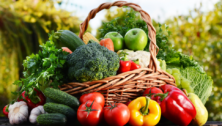Chester County Ag Notes: Farm Economy Not For the Faint Hearted

By Duncan Allison
This year farm economy is forecasted to decline 36% to reach its lowest point since 2006. Yet the last two years farm prices have been good across most of the crop and livestock industry. How can farmers cope with such highs and lows?
Farming has never been for the faint hearted. They are always at the mercy of the weather and markets over which they have absolutely no control but several additional factors are making it particularly challenging for our farmers in Chester County and across the country this year.
As a nation we spend less of our income on food than just about every other country in the world. In fact the percentage of our incomes spent on food has declined from 17.5% in 1960 to under 10% today.
In 2013 those in the highest income bracket spent about $11,000 annually on food representing only 8% of their earnings whereas the lowest income group was spending just $3,655 on food representing 36.5% of their income.
This has been possible because our farmers have been able to increase the productivity and yields of their crops and livestock on even fewer acres of total farmland.
Yields have increased from 50 bushels of corn /acre in 1960 to 171.0 in 2014 and winter wheat from 27 bushels/acre to 43 in 2014. However these global markets are oversupplied at present due to good crops so the law of supply and demand is affecting farm prices.
Corn is currently less than $4.00/bushel whereas it was over $8.00 a few years ago. Wheat stocks are at high levels in Europe and Australia and increased acreage in the US has ensured that supplies are more than adequate to meet demand so prices have been lower. Soybeans are also in abundance.
Exports have become an important component of US agriculture and projected to reach 32% of farm earnings in 2015 up from 21% in 2005.
The strong dollar and weak Chinese economy, the largest global market for soybeans – an important export market, has been affecting our exports this year and may make this projection unattainable.
Milk production (we have 275 dairy farms in 2012) has witnessed similar increases in production by breeding, nutrition and management so that milk yield per cow has increased significantly.
However fluid milk consumption has been declining in the US and the local supply in the North East exceeds demand so the excess has to be transported to plants with cheese, yogurt and dry milk processing capability involving extra cost.
Milk prices are set each month on a regional basis by a quasi-government system and have varied from around $26 per 100 lbs. in 2014 to around $16 at present which is well below the cost of production.
It takes years to build up a good dairy herd and cows need milking every single day. It is not possible to turn the tap off when milk prices get below cost of production.
Let’s look at mushrooms our most valuable farm crop in Chester County in terms of total impact on the economy. Our 60 mushroom families supply over 50% of the mushrooms consumed in the whole country.
Costs for labor, packaging and transportation have been increasing and yet prices have only been able to be increased by around one cent a pound every 2-3 years while all the input costs, such as the raw materials for compost, packaging and labor, have gone up steadily.
Mushroom growers have also increased productivity up from 3lb. /sq. ft. 50 years ago to 7.5lbs.today but it has not been possible to compensate for these increased costs.
This cyclical nature of farming and the uncertainties of crop economics from year to year require not only dedicated farmers but some committed banks. Farming is a way of life for farmers with all its challenges. Banks have to understand the variations in crop and product pricing and still be committed to the long haul.
Banks play a critical role in the farm economy by providing the lines of credit which enable vital crop and livestock inputs and equipment to be purchased even in tough times.
Governments around the world support their agricultural industry as suppliers of food and fiber. The US government has moved away from direct subsidies to providing insurance programs when crop and livestock prices drop below defined market levels.
In Chester County the last census indicated that only 272 of our 1,330 farms received a total of $1.63 million out of total county sales of $660.74 million. The current 2014 Farm Bill current Farm Bill is cost cutting legislation that will lower the safety net for farm families.
_________
 Duncan Allison gained degrees in horticulture and extension education in the UK and US and spent most of his career working for the DuPont Company developing and marketing crop protection chemicals. Recently he has written reports for a global ag publisher and for New Jersey-based international business consultants Kline & Co. For the last 16 years he has been heavily involved in the local farming of Chester County where he has lived with his wife and family since 1980.
Duncan Allison gained degrees in horticulture and extension education in the UK and US and spent most of his career working for the DuPont Company developing and marketing crop protection chemicals. Recently he has written reports for a global ag publisher and for New Jersey-based international business consultants Kline & Co. For the last 16 years he has been heavily involved in the local farming of Chester County where he has lived with his wife and family since 1980.
_______
Top Photo courtesy of Chester County Planning Commission.
Connect With Your Community
Subscribe to stay informed!
"*" indicates required fields


![95000-1023_ACJ_BannerAd[1]](https://vista.today/wp-content/uploads/2023/03/95000-1023_ACJ_BannerAd1.jpg)














































